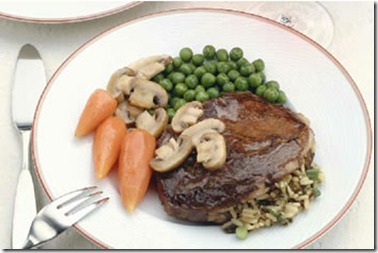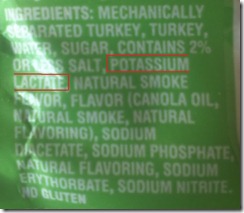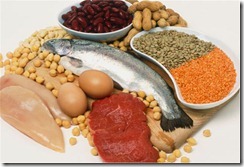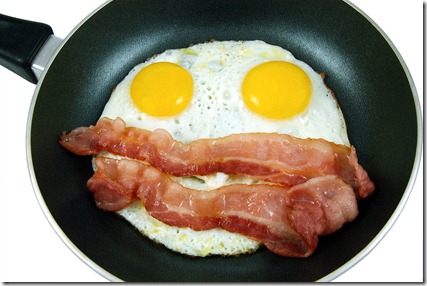I recently overheard a conversation between a man and a woman in their early 20’s. They rambled about all the different crazy  diets they and their families have dabbled with. The last one I heard was, “One time, my Mom did this diet where all she did for a month was eat like a rabbit.” At that point, I wanted to jump in and scream “You’re doing it all wrong!”
diets they and their families have dabbled with. The last one I heard was, “One time, my Mom did this diet where all she did for a month was eat like a rabbit.” At that point, I wanted to jump in and scream “You’re doing it all wrong!”
Believe it or not, eating for fat loss isn’t about starving ourselves—it’s about eating to nourish our bodies and control insulin. It’s not about eating like some tiny rodent, or even like our paleolithic ancestors (however, I do feel that our ancestors had the right idea).
There is a major difference between fat loss and weight loss. I love what Helen Kollias said in a recent article:
“My biggest peeve in the weight loss industry is that weight loss is the measurement for success. For example, here are some other ways to lose weight:
- Amputation.
- Osteoporosis.
- Stomach flu (though intestinal parasites will do in a pinch).
- Coma.
- Chemotherapy.
- Shaving all your hair off.
- Lobotomy.”
I don’t know about you, but these aren’t on my top 10 (or any number for that manner) list to lose weight. You can go on any number of crazy fad diets that have no benefit to your health. These diets will help you lose weight in terms of muscle and bone tissue, and possibly some fat. But they will probably leave you hungry and feeling deprived, and you have no chance of gaining sexy muscles.
Fat loss, on the other hand, is just that–the loss of fat and fat alone. Melting fat is our goal, and it gives way to strong muscles. It’s time to shift your thinking and not obsess over a number on the scale. It’s your body fat percentage that really counts.
The Importance of Hormones
What does it take to drop fat? Real fat loss can only occur when our bodies have the nutrients it needs to balance and maintain our hormones, as well as other functions of the body.
Our hormones and enzymes allow us to use fat as a fuel source. If these processes aren’t humming along properly, our fat is stuck on our bodies.
Have you ever heard of Hormone Sensitive Lipase (HSL)? Why care about it? HSL is an enzyme that is partially responsible for the breakdown of fat within our cells. It plays two very important roles.
- It frees up cholesterol so it can be used to create some very important gender-specific hormones. Without these hormones, we feel miserable and have a hard time losing fat.
- It breaks down fat molecules to be used as fuel. If we can’t break down fat cells, then how do we burn fat?
The “Hormone-Sensitive” part of HSL tells us that hormones control whether or not it does its job. In particular, one hormone controls it.
Insulin levels determine whether HSL is actively breaking down fat cells or if it is just floating around minding its own business. Insulin activates HSL by not being present. You read that right: the lower the levels of insulin, the more active HSL is.
There are a few things we can do to keep insulin low and nourish our bodies at the same time.
Eat Foods That Are An Ingredient
First of all, we need to stop eating like rabbits and start eating like humans are supposed to. Luckily, the way we need to eat is extremely simple. No complicated diets or fancy ingredients are needed.
My bottom line: “Eat foods that are an ingredient, not foods with ingredients.” How many ingredients are in each of the following foods? 
- Asparagus
- Almonds
- Spinach
- Lean beef
- Carrots
- Celery
- Lean chicken
Each of these foods only have one ingredient. These types of foods should make up the base of our diet. Don’t get me wrong, I enjoy many foods with multiple ingredients, but they shouldn’t form the base of our diet.
Even with foods that have multiple ingredients, the fewer the better. One of my favorite foods to have for breakfast is bacon (yes, bacon is fine to eat). For years, I would forgo regular pork bacon for turkey bacon because I was told it was “healthier.” Then I compared the ingredients of turkey bacon to pork bacon. I was dumbfounded. Turkey bacon is a mixture of stuff that God did not intend for humans to consume. On the other hand, the regular bacon consisted only of pork and spices.


I guess that’s what happens when you try to change something into something it’s not! It’s time to start reading labels. You’ll be shocked at the number of ingredients—including many scary preservatives and artificial colorings—you’ll find. Make it a priority to eat real, whole food.
Fill Your Plate With Veggies
I won’t spend much time on this one. We all know that veggies are great for us. They provide vitamins, minerals, phytochemicals, antioxidants, and fiber. I recommend trying to get 5-10 fist-size servings of these every day.
Can’t stand eating that many? Blend some into a shake. Spinach is virtually tasteless when mixed in a fruit smoothie. Eating plentiful veggies will kick-start your body’s fat-burning capabilities.
Feast on Lean Protein
Don’t be afraid of protein—it’s the building block of our muscles. Just by eating plenty of it, we can get a little more toned, though not enough to get too excited about. When you add some strength training to the mix, a sculpted figure will begin to emerge.
Add these lean proteins to your plate.
 Lean meats: lean beef, chicken, turkey, bison, venison
Lean meats: lean beef, chicken, turkey, bison, venison- Fish: salmon, tuna, cod, roughy
- Eggs
- Dairy: cottage cheese, Greek yogurt, cheese, etc.
- Beans, peas, legumes, tofu, tempeh, etc.
- Protein supplements
- Milk-based: whey, casein, milk protein blends
- Plant-based: pea, hemp, rice, etc.
Protein is a very thermogenic nutrient, meaning that we increase our metabolism just by eating it. Eat your protein and veggies together, and you have a very tasty and healthy meal.
Eat Whole Carbs
The key with carbs is to eat “whole grains.” I hate to be the bearer of bad news, but that cereal, oatmeal, or the bread labeled “whole wheat bread” in your cupboard isn’t actually whole grain. When these products are made, they take the grain and process it, which means they smash it up and separate it into parts. Then they might combine the parts into the finished product and slap a pretty little “whole grain” sticker on the front, hoping that you will never know the difference.
Whole grain is just that…whole. The problem with processed carbohydrates is that the steps taken actually predigest our food in a way. This causes it to hit our bloodstream faster and spike our insulin even more than normal. Remember that high insulin means a lazy HSL, leading to little fat breakdown.
Examples of whole grains are steel cut oats, quinoa, buckwheat, and amaranth. These happen to be gluten-free, as well. Some other safe carb sources are wild rice and sweet potatoes.
Eat Fat!
Make sure to eat your fat!
Wait, did I really just say that? How can fat be a good thing to eat when you’ve heard nothing but advice on eating a low-fat diet?
With all of these low-fat and fat free-foods and supplements that keep us from absorbing fat in grocery stores, it’s hard to remember that fat is really good for us. Do you think your grandparents grew up being told that butter and bacon were terrible for you? With what we hear in the media, you would think that fat was some evil monster out to kill us.
It may be a paradigm shift to realize this, but fats are important for so many processes in our bodies. They make up the cell walls of every single cell in our bodies, and they are vital for hormone production and regulation.
Not only that, but fats help us feel satisfied for a much longer period of time, which keeps us fuller longer and less likely to snack on junk.
But the question is, are all fats good for us? Absolutely not. But you might be surprised to learn which fats are good and which you should avoid.
Mono-Unsaturated Fats
These are found in nuts and nut butter, avocados, and olive oil. This kind of fat is very good for you. I recommend getting about 1-2 tablespoons of these kinds of fat with each meal.
Poly-Unsaturated Fats
These are mostly found in vegetable oil, canola oil, safflower oil, soy oil, and other seed oils. These should be avoided. We have been told for years that these fats are good for us, but they are NOT! Plain and simple, they are manmade, processed fats. If man makes it, it probably shouldn’t be eaten.
Saturated Fats
These are found in animal fats, butter, and coconut oil. We have been taught that these fats are the evil fats linked to heart disease and high cholesterol. Guess what? Emerging scientific research tells us that this is not the case.
Some of these studies were completed nearly two decades ago, but are only now coming to light because the researchers were trying to show that saturated fats were killing us. What they saw was that saturated fat eaters were living longer and healthier lives, but because their research results went against their predictions, they didn’t publish the results. The food industry and lobbyists also kept us in the dark for their own reasons. However, 20 years later, these findings are being published and shared because more and more research is showing similar results. To sum it all up, saturated fat IS GOOD for us.
I am not saying that we should eat a stick of pure butter with each meal, but some bacon and eggs fried in butter is a healthier option for breakfast compared to oatmeal. It will also keep you more satisfied and fuller for longer. So get out there and enjoy your bacon. 
Let me know your thoughts and questions by leaving a comment below.

Awesome information! My husband and I are very excited about the web site you’ve launched!
Thank you. I will do my best to post the best information I can.
Oh man! I thought I was doing so good with my oatmeal every morning. 🙂
Where did you find bacon that wasn’t full of all the chemicals? It would be nice to make my husband happy and still feel good about what I’m feeding him!
You have to look for it. I have found it in every grocery store that I have been to. You just have to look at every package until you find the uncured bacon. Then you are good.
Great article and very informative with info I can definitely put to use
I love this article! I just Pinned it 🙂 I love that your program focusing on EATING for FAT LOSS instead of DIETING for WEIGHT LOSS.
I should probably read this a few times so I can retain all of the information. Thanks!